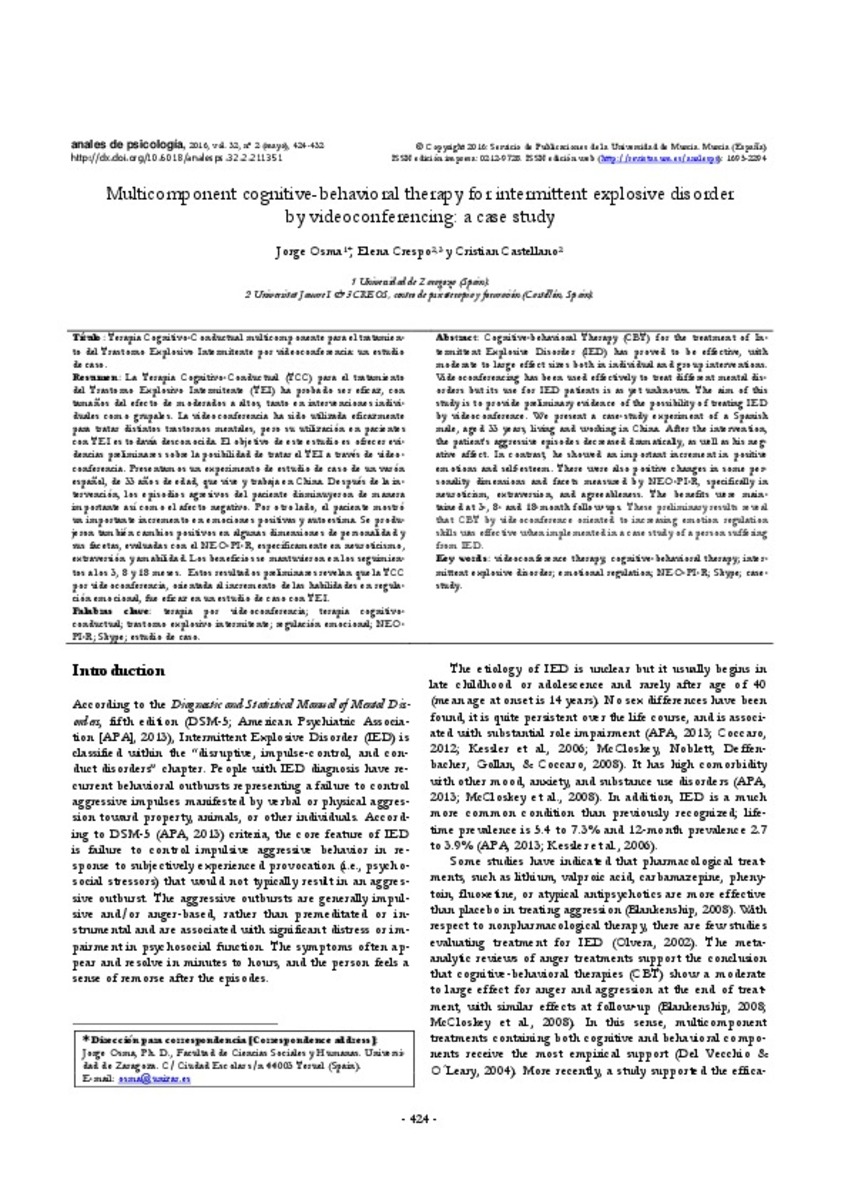Mostrar el registro sencillo del ítem
Multicomponent cognitive-behavioral therapy for intermittent explosive disorder by videoconferencing: a case study
| dc.contributor.author | Osma López, Jorge Javier | |
| dc.contributor.author | Crespo Delgado, Elena | |
| dc.contributor.author | Castellano, Cristian | |
| dc.date.accessioned | 2016-06-21T15:29:23Z | |
| dc.date.available | 2016-06-21T15:29:23Z | |
| dc.date.issued | 2016 | |
| dc.identifier.issn | 0212-9728 | |
| dc.identifier.issn | 1695-2294 | |
| dc.identifier.uri | http://hdl.handle.net/10234/160970 | |
| dc.description.abstract | La Terapia Cognitivo-Conductual (TCC) para el tratamiento del Trastorno Explosivo Intermitente (TEI) ha probado ser eficaz, con tamaños del efecto de moderados a altos, tanto en intervenciones individuales como grupales. La videoconferencia ha sido utilizada eficazmente para tratar distintos trastornos mentales, pero su utilización en pacientes con TEI es todavía desconocida. El objetivo de este estudio es ofrecer evidencias preliminares sobre la posibilidad de tratar el TEI a través de videoconferencia. Presentamos un experimento de estudio de caso de un varón español, de 33 años de edad, que vive y trabaja en China. Después de la intervención, los episodios agresivos del paciente disminuyeron de manera importante así como el afecto negativo. Por otro lado, el paciente mostró un importante incremento en emociones positivas y autoestima. Se produjeron también cambios positivos en algunas dimensiones de personalidad y sus facetas, evaluadas con el NEO-PI-R, específicamente en neuroticismo, extraversión y amabilidad. Los beneficios se mantuvieron en los seguimientos a los 3, 8 y 18 meses. Estos resultados preliminares revelan que la TCC por videoconferencia, orientada al incremento de las habilidades en regulación emocional, fue eficaz en un estudio de caso con TEI | ca_CA |
| dc.description.abstract | Cognitive-behavioral Therapy (CBT) for the treatment of Intermittent Explosive Disorder (IED) has proved to be effective, with moderate to large effect sizes both in individual and group interventions. Videoconferencing has been used effectively to treat different mental disorders but its use for IED patients is as yet unknown. The aim of this study is to provide preliminary evidence of the possibility of treating IED by videoconference. We present a case-study experiment of a Spanish male, aged 33 years, living and working in China. After the intervention, the patient’s aggressive episodes decreased dramatically, as well as his negative affect. In contrast, he showed an important increment in positive emotions and self-esteem. There were also positive changes in some personality dimensions and facets measured by NEO-PI-R, specifically in neuroticism, extraversion, and agreeableness. The benefits were maintained at 3-, 8- and 18-month follow-ups. These preliminary results reveal that CBT by videoconference oriented to increasing emotion regulation skills was effective when implemented in a case study of a person suffering from IED. | ca_CA |
| dc.description.sponsorShip | Financed by Gobierno de Aragón (Dpt. Industria e Innovación), European Social Fund and CREOS, centro de psicoterapia y formación. | ca_CA |
| dc.format.extent | 9 p. | ca_CA |
| dc.format.mimetype | application/pdf | ca_CA |
| dc.language.iso | eng | ca_CA |
| dc.publisher | Universidad de Murcia | ca_CA |
| dc.relation.isPartOf | anales de psicología, 2016, vol. 32, nº 2 (mayo), 424-432 | ca_CA |
| dc.rights | © Servicio de Publicaciones, Universidad de Murcia, 2016 The works are published in the online edition of the journal under a Creative Commons Attribution-NonCommercial 4.0 (legal text). You can copy, use, distribute, transmit and publicly display, provided that: i) you cite the author and the original source of publication (magazine, editorial and URL of the work), ii) are not used for commercial purposes, iii ) mentions the existence and specifications of this license. | ca_CA |
| dc.rights | Attribution-NonCommercial 4.0 Spain | * |
| dc.rights.uri | http://creativecommons.org/licenses/by-nc/4.0/ | * |
| dc.subject | terapia por videoconferencia | ca_CA |
| dc.subject | terapia cognitivoconductual | ca_CA |
| dc.subject | trastorno explosivo intermitente | ca_CA |
| dc.subject | regulación emocional | ca_CA |
| dc.subject | NEOPI-R | ca_CA |
| dc.subject | Skype | ca_CA |
| dc.subject | estudio de caso | ca_CA |
| dc.subject | videoconference therapy | ca_CA |
| dc.subject | cognitive-behavioral therapy | ca_CA |
| dc.subject | intermittent explosive disorder | ca_CA |
| dc.subject | emotional regulation | ca_CA |
| dc.subject | casestudy | ca_CA |
| dc.title | Multicomponent cognitive-behavioral therapy for intermittent explosive disorder by videoconferencing: a case study | ca_CA |
| dc.type | info:eu-repo/semantics/article | ca_CA |
| dc.identifier.doi | http://dx.doi.org/10.6018/analesps.32.2.211351 | |
| dc.rights.accessRights | info:eu-repo/semantics/openAccess | ca_CA |
| dc.relation.publisherVersion | http://revistas.um.es/analesps/article/view/analesps.32.2.211351 | ca_CA |
Ficheros en el ítem
Este ítem aparece en la(s) siguiente(s) colección(ones)
-
PSB_Articles [1310]
Articles de publicacions periòdiques
Excepto si se señala otra cosa, la licencia del ítem se describe como: © Servicio de Publicaciones, Universidad de Murcia, 2016
The works are published in the online edition of the journal under a Creative Commons Attribution-NonCommercial 4.0 (legal text). You can copy, use, distribute, transmit and publicly display, provided that: i) you cite the author and the original source of publication (magazine, editorial and URL of the work), ii) are not used for commercial purposes, iii ) mentions the existence and specifications of this license.








